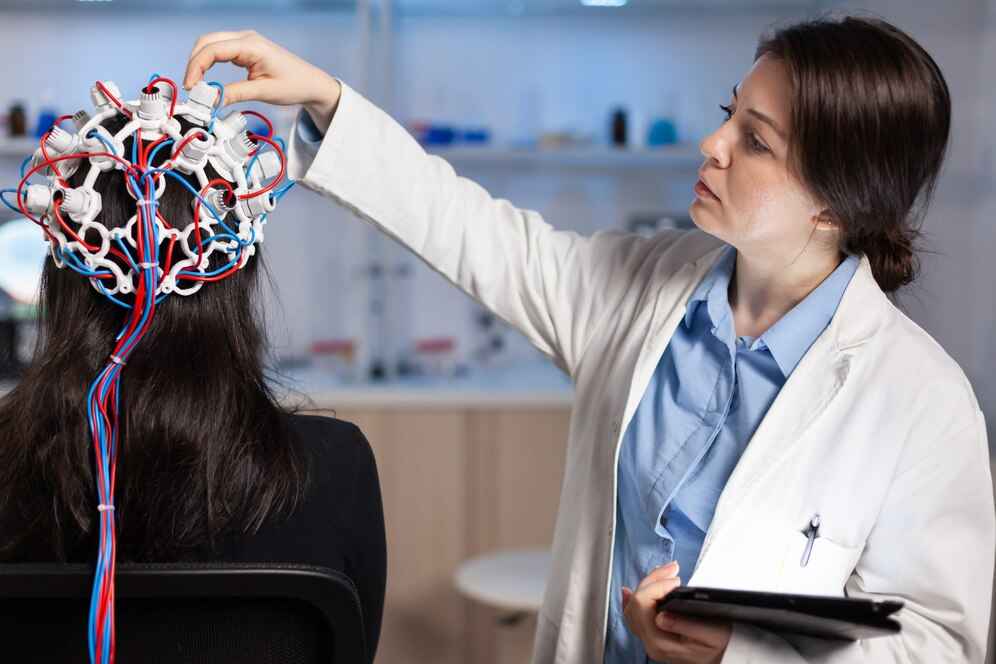Depression is still one of the most difficult mental illnesses, especially for people who have symptoms that don’t go away. Although many people find relief from traditional therapies like medicine and psychotherapy, their effectiveness varies. One innovative remedy is transcranial magnetic stimulation (TMS). This ground-breaking therapy significantly reduces depressed symptoms by stimulating particular brain regions with magnetic pulses.
This comprehensive blog will explore the science, benefits, safety, and process of TMS transcranial magnetic stimulation and its role in modern mental health care.
What is Transcranial Magnetic Stimulation (TMS) Therapy?
The FDA has approved TMS therapy as a non-invasive treatment for major depressive disorder (MDD) and other mental health issues. In contrast to conventional therapies, it directly targets the brain regions in charge of mood regulation by activating nerve cells there using magnetic fields.
How TMS Works
A customized magnetic coil is applied to the patient’s scalp during TMS treatment. Repetitive magnetic pulses from this coil enter the skull and travel to particular brain parts, especially the prefrontal cortex. By stimulating dormant nerve cells, these pulses enhance brain activity and lessen depressed symptoms.
Since TMS is non-invasive and doesn’t involve sedation or anesthesia, it’s a safer option than electroconvulsive therapy (ECT). The medical profession has also extensively acknowledged its efficacy when conventional treatments fail.
How Does TMS Therapy Work for Depression?
Reduced activity in specific brain regions, especially the dorsolateral prefrontal cortex, is frequently linked to depression. TMS, or transcranial magnetic stimulation, specifically targets this area, using magnetic pulses to alter brain activity and enhance neuronal connectivity.
The Science Behind TMS
TMS therapy induces tiny electrical currents in the brain through magnetic pulses. These currents improve communication between brain cells by aiding in the “reset” of malfunctioning neuronal circuits. Over time, this stimulation helps to alleviate depressive symptoms by restoring normal activity in the afflicted areas.
Comparison to Other Treatments
- Medications: Antidepressants remain a common first-line treatment for depression, working by altering brain chemistry to balance neurotransmitters such as serotonin and dopamine. However, these changes can take weeks or months to produce noticeable results. Additionally, many patients experience unwanted side effects, including fatigue, weight gain, nausea, and sexual dysfunction. For some, these side effects outweigh the benefits, leading them to discontinue treatment prematurely.
- Psychotherapy: Talk therapy, such as cognitive-behavioral therapy (CBT) or interpersonal therapy (IPT), is another cornerstone of depression treatment. While it can be highly effective, particularly for mild to moderate depression, it requires a significant time investment, often spanning months or even years. For individuals with severe or treatment-resistant depression, psychotherapy alone may not provide sufficient relief, highlighting the need for adjunctive or alternative therapies.
- TMS Therapy: Unlike medications and psychotherapy, TMS transcranial magnetic stimulation targets the brain’s mood-regulating areas, specifically the dorsolateral prefrontal cortex. This allows for faster and more focused relief, particularly for patients with treatment-resistant depression who have not responded to traditional approaches. As a non-invasive and drug-free option, TMS therapy also avoids the systemic side effects associated with medications. It can complement other forms of therapy, offering a well-rounded solution for managing depression.
The Benefits of TMS Therapy
Several benefits make transcranial magnetic stimulation an appealing choice for people looking for efficient depression treatment. Let’s examine the main advantages of this novel treatment:
Non-Invasive and Drug-Free
TMS therapy is not dependent on medication, in contrast to antidepressants. For people with sensitivities or medical issues, this provides a safer option by removing the possibility of drug-related adverse effects and interactions.
Minimal Side Effects
The side effects of TMS transcranial magnetic stimulation are typically mild and short-lived. Most patients report only slight discomfort during treatment, such as:
- Temporary headaches
- Scalp tingling or sensitivity
Long-Lasting Results
Studies show that numerous patients report long-term alleviation with TMS therapy. A sizable portion of patients report long-lasting improvements in their mood and quality of life following the completion of an entire course of treatment.
Customizable Treatment
Since each patient is different, TMS therapy can be customized to fit their requirements. To achieve the best results, clinicians modify the frequency, severity, and length of treatment sessions in response to the patient’s symptoms and reactions.
Is TMS Therapy Safe? Exploring Potential Risks and Side Effects
Safety is the top priority for anyone considering a new treatment. Thankfully, transcranial magnetic stimulation, or TMS, has undergone extensive testing and is a safe and efficient treatment for depression.
Safety Backed by Research
The safety and effectiveness of TMS transcranial magnetic stimulation have been thoroughly investigated since it was approved by the FDA in 2008 for the treatment of severe depressive disorder. Clinical research and practical applications continuously demonstrate its safety for most patients.
Commonly Reported Side Effects
While TMS therapy is generally well-tolerated, some patients may experience:
- Mild headaches
- Scalp discomfort at the treatment site
- Lightheadedness
These effects are temporary and usually resolve within hours after a session. Adherence to strict safety protocols ensures that risks remain minimal.
What to Expect During TMS Treatment Sessions
TMS therapy is designed to be as comfortable and convenient as possible. Here’s what patients can expect during their treatment journey:
Pre-Treatment Evaluation
Patients undergo a thorough evaluation prior to beginning treatment. This includes a review of medical history, a mental health evaluation, and, in certain situations, brain imaging. These procedures assist medical professionals in identifying the best course of action for each patient.
Treatment Sessions
- Setup: For each session, the patient is situated in a cozy chair. The clinician carefully places the magnetic coil on the patient’s head, targeting the precise brain areas involved in mood regulation. Due to the exact location, appropriate stimulation ensures maximum effectiveness.
- Duration: Sessions usually run 20 to 40 minutes, depending on the individual’s response and the treatment plan. This reasonable period allows most patients to integrate therapy into their daily schedules.
- Frequency: A standard treatment course involves five sessions per week over 4-6 weeks, though this may vary based on the patient’s progress and clinician recommendations.
- Experience: Patients remain fully awake and alert throughout the procedure. The sensation is often described as a mild tapping or tingling on the scalp, which is generally well-tolerated. Some patients find the rhythmic pulse almost relaxing after a few sessions.
Post-Session Recovery
Among its most alluring features is that TMS therapy doesn’t require a recuperation period. Following each session, patients can promptly return to their usual activities, such as work or school. Because of this convenience, TMS is a very accessible therapy option for people with hectic lifestyles.
TMS therapy guarantees that patients can concentrate on their path to better mental health by offering a simple, non-invasive procedure that causes little interference with day-to-day activities.
Why TMS is a Game-Changer for Depression
Depression is a complicated mental illness with many facets that frequently require an all-encompassing approach to treatment. While many succeed with traditional methods like medicine and psychotherapy, others may not benefit from them. A novel and scientifically proven solution to depression that targets the underlying reasons for treatment-resistant depression is magnetic therapy.
TMS therapy is revolutionary because it targets certain brain areas linked to mood regulation, like the dorsolateral prefrontal cortex. It reduces depressed symptoms by reestablishing normal brain activity by stimulating dormant neural connections. In addition to distinguishing it from traditional therapies, this precision-based approach gives people who have struggled with chronic illnesses for years new hope.
Many people find TMS transcranial magnetic stimulation a feasible and accessible alternative because it is noninvasive, drug-free, and has few adverse effects. When other therapies have failed, it gives patients a choice, resulting in long-lasting alleviation and an enhanced quality of life.
Conclusion
For individuals battling depression who have not found relief through traditional methods, TMS transcranial magnetic stimulation offers a lifeline. This non-invasive, effective, and scientifically validated treatment provides hope and healing for those living with treatment-resistant depression.
We are committed to guiding you toward a brighter future at Insight Choices. Take the first step today—schedule your consultation and discover how TMS therapy can transform your life.
Take the First Step Toward a Brighter Tomorrow
If you or a loved one has been struggling with depression and traditional treatments haven’t provided the relief you need, TMS transcranial magnetic stimulation could be the answer. This innovative, non-invasive therapy has helped countless individuals reclaim their lives and find hope again.
Don’t let depression define your future. Schedule a consultation with Insight Choices today and discover how magnetic treatment for depression can transform your journey toward healing and happiness. The first step to a brighter tomorrow starts here.
FAQ’s
What is TMS therapy, and how does it work?
TMS therapy is a non-invasive treatment that uses magnetic pulses to stimulate underactive areas of the brain involved in mood regulation. This process helps alleviate symptoms of depression by resetting dysfunctional neural pathways.
Who is a candidate for TMS therapy?
Candidates include individuals with major depressive disorder who have not responded to traditional treatments like antidepressants or psychotherapy. Patients must undergo an evaluation to determine their suitability.
How long do the effects of TMS last?
The effects of TMS transcranial magnetic stimulation vary by individual but are often long-lasting. Many patients experience significant improvement in their symptoms for months or years after completing treatment.
Does TMS have side effects?
Side effects are generally mild and include headaches or scalp sensitivity. These are temporary and usually resolve quickly after the session.
How much does TMS therapy cost, and is it covered by insurance?
The cost of TMS therapy depends on the treatment plan and provider. Many insurance plans cover TMS for depression, and patients are encouraged to verify coverage with their provider.

Dr. Chang is a highly respected psychiatrist with extensive experience serving patients in the greater Los Angeles area. With a distinguished background in psychiatry, he has dedicated his career to advancing mental health care through both clinical practice and academic contributions.

